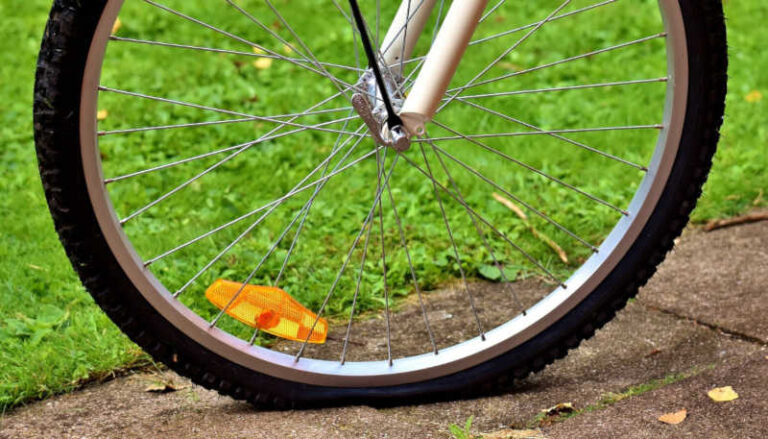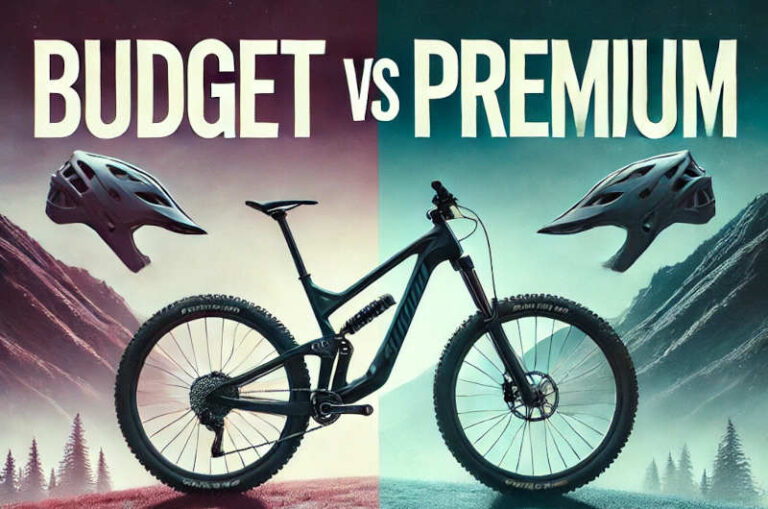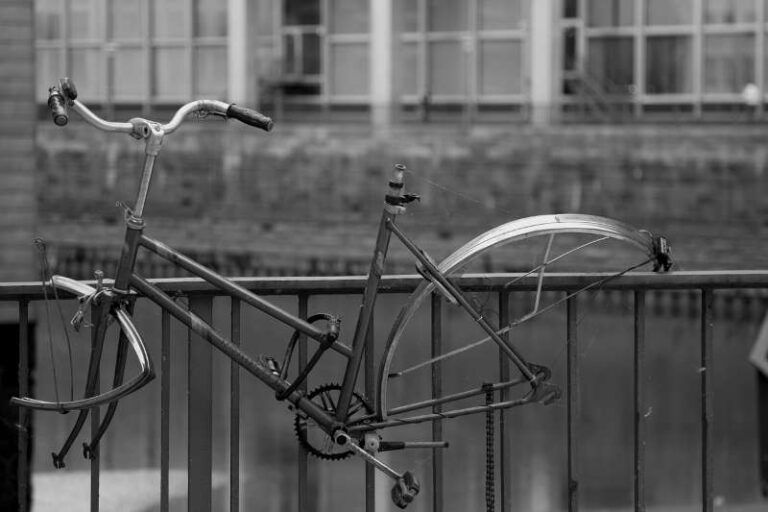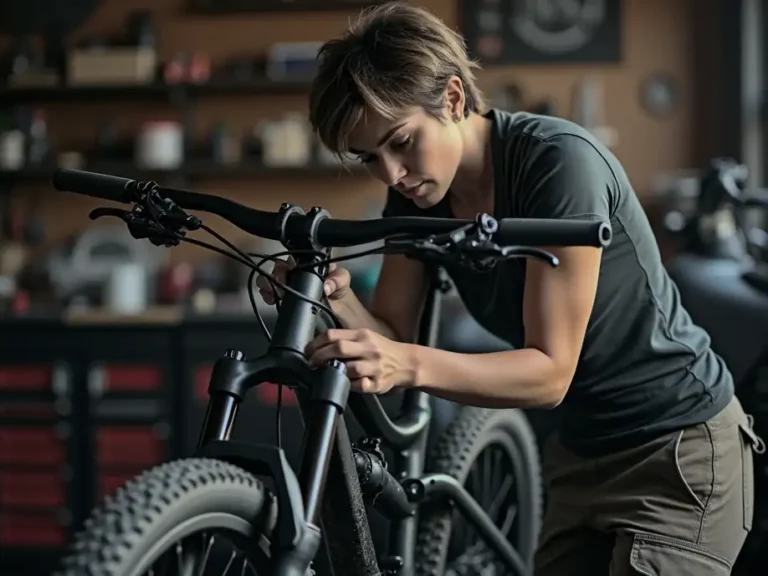What’s the best way to store my bike when not in use?
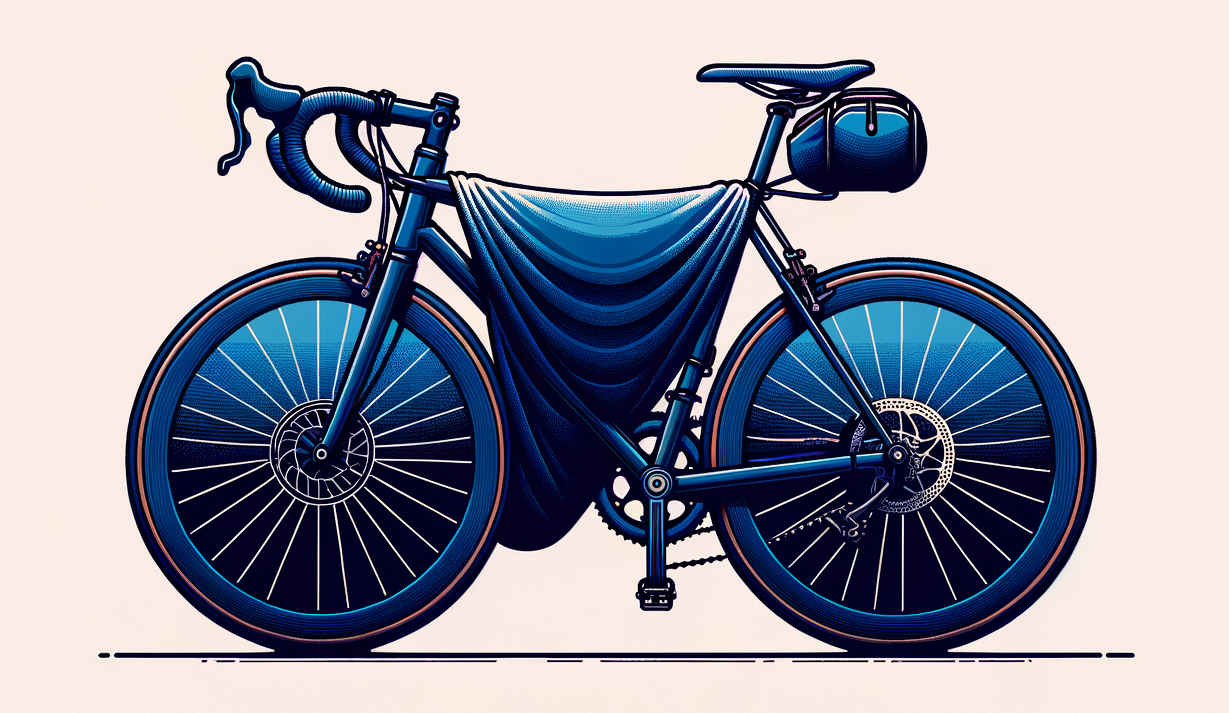
Storing a bicycle properly when not in use is important for maintaining its condition and ensuring it lasts a long time. The last thing you want is to take out your bike after a period of storage and find problems. You just want to ride!
With a bit of planning and preparation, you can avoid issues and be ready for that fantastic first ride of the season.
Ten tips for the best way to store a bicycle:
Indoor Storage
Whenever possible, store your bicycle indoors. This protects it from the elements, such as rain, snow, and extreme temperatures, which can cause rust and deterioration.
Where you store it depends, of course, on the space you have available. Some spots to consider are:
- Garage – Leaves more room in your house for other items.
- Basement – Ideally in a dry area of your basement.
- Spare room or closet – Keeps it out of your main living areas.
- Living room – If you live in a small space like an apartment.
- Under your stairs – An often underutilized area of your house.
- Shed – Protects from the elements except the cold. Be sure to use a good lock and install special hinges which hide the door hinge screws to help stop thieves from getting in as easily.
- Attic – A finished attic is a great way to keep your bike out of the way if storing for an extended period. Unfinished attics, however, can sometimes be EXTREMELY hot in the summer if lacking proper attic air circulation. Check the temperature of your attic on some hot summer days before deciding to store your bike there. The attic in my house reaches a sweltering 158 F / 70 C! I wouldn’t want to put anything of value up there.
- Balcony – Although technically outdoors, many balconies are protected from rain and snow. Not as ideal as indoors, but better than being exposed fully.
Use a Bike Cover
You might think a bike-cover is a bike-cover is a bike-cover, right? Nope! If you’ve never looked into one before, a surprisingly wide range of bicycle covers are available to choose from. You’ll find everything from light dust covers to a loose tarp-like material to sturdy waterproof rip-stop fabric that is heat sealed and double stitched.
Indoor bike covers actually do ‘double-duty’ – protecting your bike from dust and protecting your home from the grease and grime on your bike. If indoor storage isn’t an option, opt for a weatherproof bike cover.
Here’s a breakdown of some types of covers available:
Outdoor All-Weather Covers
- Material: Typically made from heavy-duty, waterproof materials like polyester or nylon with UV protection.
- Unique Features: These covers are designed to withstand harsh outdoor conditions, including rain, snow, dust, and UV rays. They often come with elastic hems and adjustable straps to ensure a snug fit.
- Benefits: Provides comprehensive protection from the elements, making them ideal for bikes stored outside or on a balcony.
Indoor Dust Covers
- Material: Made from lightweight, breathable fabrics like cotton or polyester.
- Unique Features: These covers are designed to keep dust and dirt off the bike while stored indoors. They are usually less bulky and easier to handle than all-weather covers.
- Benefits: Prevents dust accumulation and keeps the bike clean, ideal for garage or basement storage where exposure to dirt is minimal.
Travel Covers
- Material: Often constructed from durable, padded materials like thick nylon or canvas.
- Unique Features: These covers are designed for use during transportation, providing extra padding and protection against scratches and impacts. They may come with handles or straps for easy carrying.
- Benefits: Protects the bike during travel, whether in a car, on a plane, or on public transport, reducing the risk of damage.
Full Enclosure Covers
- Material: Typically made from waterproof and UV-resistant materials.
- Unique Features: These covers provide a complete enclosure for the bike, including the bottom, often featuring a zippered design for easy access.
- Benefits: Offers maximum protection from all sides, ideal for long-term storage in environments where the bike needs to be completely sealed off from dust, moisture, and pests.
Each type of bicycle cover is designed to cater to specific storage and protection needs, ensuring that your bike remains in optimal condition regardless of where and how it is stored.
Want more specific recommendations? Bicycling.com has a list of 8 covers they recommend.
Clean and Lubricate
Before storing your bike, clean it thoroughly and lubricate the chain and other moving parts. This prevents rust and keeps the components in good working order.
How to Clean Your Bike
You’ll need a bucket of warm soapy water (mild dish soap works well), a sponge, a set of brushes (including a soft brush and a stiff brush), degreaser, and some clean rags or towels.
Initial Rinse: Gently rinse your bike with water to remove loose dirt and grime. Avoid using high-pressure sprays as they can force water into bearings and other sensitive areas, potentially causing damage over time.
Clean the Frame and Components: Using soapy water and a sponge, scrub the frame, handlebars, saddle, and wheels. For tougher spots, use a soft brush. Clean each component thoroughly, ensuring that you reach into crevices where dirt often accumulates.
Degrease the Drivetrain: Apply a bike-specific degreaser to the chain, cassette, chainrings, and derailleur jockey wheels. Let the degreaser sit for a few minutes to break down the grease and grime. Use a stiff brush or a chain cleaning tool to scrub the drivetrain components, then rinse off the degreaser completely.
You’ve got your pick of many degreasers available on the market. Brands include:
- Muc-Off Bio Chain Cleaner
- Finish Line Speed Degreaser
- Park Tool CB-4 Bio ChainBrite
- Pedro’s Oranj Peelz Citrus Degreaser:
- WD-40 Bike Degreaser
- ProGold ProLink Chain Cleaner and Degreaser
- Simple Green Bike Cleaner and Degreaser
- Rock N Roll Miracle Red Degreaser
- White Lightning Clean Streak
- Zefal Bike Bio Degreaser
Dry the Bike: Use clean rags or towels to thoroughly dry your bike, paying special attention to the chain and other metal parts to prevent rust. Make sure all components are dry before moving on to lubrication.
How to Lubricate Your Bike
Lubricate the Chain: With your bike on a stand or held securely, apply lubricant to each link of the chain while slowly rotating the pedals backward. Ensure even coverage by applying one drop per link .
Remove Excess Lubricant: After allowing the lubricant to penetrate for a few minutes, use a clean rag to wipe off any excess. Excess lubricant can attract dirt and grime, which can lead to more wear and tear on your drivetrain .
Lubricate Other Moving Parts: Apply a small amount of lubricant to the pivot points of the derailleurs, brake levers, and any other moving parts that may need it. Be careful to avoid getting lubricant on the brake pads or rotors, as this can reduce braking performance .
Elevate the Bike
Use a wall-mounted rack, ceiling hook, or a free-standing bike stand to elevate your bike off the ground.
Elevating your bicycle in storage is beneficial for several reasons, keeping your tires and your sanity happy:
Prevents Tire Deformation and Damage: Keeping your bicycle elevated prevents constant pressure on the tires, which can lead to flat spots and deformation over time. Imagine leaving a pumpkin on your sofa for months – eventually, you’d have a pumpkin-shaped dent, right? The same thing happens with your bike tires if they sit in one spot too long. As the weight of the bicycle pressing down on the same section of the tire can cause it to lose its round shape and potentially lead to tire damage or reduced performance when you next ride.
Gives You More Room to Breathe by Saving Floor Space and Reducing Clutter: Storing your bicycle off the ground maximizes available floor space, making your storage area more organized and efficient. This can be particularly advantageous in small spaces, such as apartments or garages, where floor space is at a premium. Plus, it helps avoid the bike getting knocked over or buried under other items, avoiding potential damage. Great for a tidy space and to reduce profanities coming from your mouth if you need to move your bike to get to other things or if you whack your elbow on an unruly handlebar.
Avoid Direct Sunlight
Store your bike away from direct sunlight, as UV rays can cause the paint to fade and the rubber parts to dry out and crack.
Just like your skin can get damaged by the sun, so can your bike. Prolonged exposure to UV rays can fade the paint and degrade rubber components like tires and grips. Think of it as protecting your bike’s skin from sunburn.
Components can also heat up in the sun which isn’t ideal for lubricants and fluids such as for suspension and hydraulic brakes.
Stable Environment
If possible, choose a storage location with a stable temperature and humidity level. Avoid damp basements or hot attics, as extreme conditions can damage your bike.
Fluctuating humidity levels can cause condensation, leading to rust and corrosion on the frame, chain, and gears. By keeping the environment stable, you minimize the risk of moisture buildup, keeping your bike’s metal parts in pristine condition.
Optimizing the air in your tires (although the jury is still out on the best way)
There’s a bit of debate on whether to inflate or slightly deflate the tires for long term storage. Here are some benefits of each approach:
Inflating Your Bicycle Tires
- Maintains Tire Shape: Keeping the tires inflated helps maintain their shape and prevents the rubber from developing flat spots where the bike makes contact with the ground.
- Ready to Ride: If the tires are inflated, the bike is ready to use without needing immediate maintenance. This is convenient if you plan to use it occasionally during the storage period.
- Prevents Rim Damage: Properly inflated tires help prevent the rims from resting directly on the ground, which can damage the rims over time.
Slightly Deflating Your Bicycle Tires
- Reduces Pressure on Seams: Slightly deflating the tires can reduce the constant pressure on the seams of the tire and inner tube, potentially extending their lifespan by preventing slow leaks and blowouts.
- Temperature Fluctuations: If the storage area experiences significant temperature changes, slightly deflated tires can better accommodate the expansion and contraction of air inside the tires, reducing the risk of bursting or damaging the tire.
So depending on your situation:
Inflate if: You want to maintain the tire shape and ensure the bike is ready to ride at any time.
Slightly deflate if: You’re concerned about tire pressure changes due to temperature fluctuations or want to reduce the strain on tire seams.
Protect the Saddle
Cover the saddle with a plastic bag or a dedicated saddle cover.
This is a quick but effective step that prevents damage from moisture and dust. Bike saddles, especially those made from leather or high-quality synthetic materials, can be damaged by prolonged exposure to moisture and dust. Moisture can cause mold and mildew, which can degrade the saddle’s material and structure over time.
Secure the Bike
Use a sturdy lock to protect it from theft, especially in a shared space.
Seems like this should be obvious, but if you are storing your bike on a wall or hung from the ceiling in your garage, you might overlook locking it up and put it off until it’s too late. Thieves don’t care where your bike is. If it’s tempting, they’ll take it. Lock it up well or you may regret it.
A friend of mine had 5 e-bikes stolen from his garage simply because he forgot to lock the garage door.
See our article about securing your bike for more in-depth information.
Regular Check-ups
Even when not in use, check your bike periodically. Ensure the that nothing has been leaned against it and that nothing else in the environment has changed.
By following these tips, you’ll ensure your bike stays in top-notch condition, always ready to roll whenever adventure calls.

by: Cory Willins
Cory is a dynamic and passionate content writer, specializing in sports-related topics. With over a decade of experience in the field, Cory has established… read more

